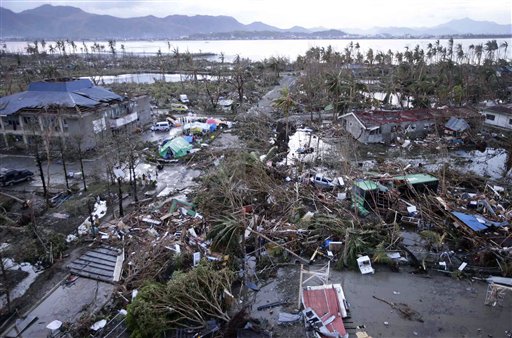(AP) Over 100 dead as typhoon slams central Philippines
By JIM GOMEZ
Associated Press
TACLOBAN, Philippines
**UPDATE** AFP reports the Red Cross estimates about 1,200 people have died as a result of the typhoon.
The central Philippine city of Tacloban was in ruins Saturday, a day after being ravaged by one of the strongest typhoons on record, as horrified residents spoke of storm surges as high as trees and authorities said they were expecting a “very high number of fatalities.”
At least 138 people were confirmed dead in the aftermath of Typhoon Haiyan, which slammed into six central Philippine islands on Friday, wiping away buildings and leveling seaside homes. At least 118 of the deaths were on hardest-hit Leyte Island, where Tacloban is located, said national disaster agency spokesman Maj. Reynaldo Balido.
But after arriving in Tacloban on Saturday, Interior Secretary Max Roxas said it was too early to know how many people had died in the storm, which was heading toward Vietnam after moving away from the Philippines.
The Philippine Red Cross and its partners were preparing for a major relief effort “because of the magnitude of the disaster,” said the agency’s chairman, Richard Gordon.
The airport in Tacloban, a city of 200,000 located about 580 kilometers (360 miles) southeast of Manila, looked like a muddy wasteland of debris Saturday, with crumpled tin roofs and upturned cars. The airport tower’s glass windows were shattered, and air force helicopters were busy flying in and out at the start of relief operations.
U.S. Marine Col. Mike Wylie surveyed the damage in Tacloban prior to possible American assistance. “The storm surge came in fairly high and there is significant structural damage and trees blown over,” said Wylie, who is a member of the U.S.-Philippines Military Assistance Group based in Manila.
U.S. Secretary of State John Kerry said in a statement that America “stands ready to help.”
Weather officials said Haiyan had sustained winds of 235 kilometers per hour (147 miles per hour) with gusts of 275 kph (170 mph) when it made landfall. By those measurements, Haiyan would be comparable to a strong Category 4 hurricane in the U.S., and nearly in the top category, a 5.
Hurricanes, cyclones and typhoons are the same, but have different names in different parts of the world.
One Tacloban resident said he and others took refuge inside a parked Jeep to protect themselves from the storm, but the vehicle was swept away by a surging wall of water.
Vice Mayor Jim Pe of Coron town on Busuanga, the last island battered by the typhoon before it blew away to the South China Sea, said most of the houses and buildings there had been destroyed or damaged. Five people drowned in the storm surge and three others are missing, he said by phone.
Philippine broadcaster ABS-CBN showed fierce winds whipping buildings and vehicles as storm surges swamped Tacloban with debris-laden floodwaters.
In the aftermath, people were seen weeping while retrieving bodies of loved ones inside buildings and on a street that was littered with fallen trees, roofing material and other building parts torn off in the typhoon’s fury. All that was left of one large building whose walls were smashed in were the skeletal remains of its rafters.
ABS-CBN television anchor Ted Failon, who was able to report only briefly Friday from Tacloban, said the storm surge was “like the tsunami in Japan.”
Before he left Tacloban on Saturday, Failon said he saw people like a “pack of rats” looting a department store taking whatever they could lay their hands on including refrigerators and TV sets. TV footage showed a group of men smiling as they walked away with a large ice cream freezer and other goods.
The Philippine television station GMA reported that its news team saw 11 bodies, including that of a child, washed ashore Friday and 20 more bodies at a pier in Tacloban hours after the typhoon ripped through the coastal city.
At least 20 more bodies were taken to a church in nearby Palo town that was used as an evacuation center but had to be abandoned when its roofs were blown away, the TV network reported. TV images showed howling winds peeling off tin roof sheets during heavy rain.
Ferocious winds felled large branches and snapped coconut trees. A man was shown carrying the body of his 6-year-old daughter who drowned, and another image showed vehicles piled up in debris.
Nearly 800,000 people were forced to flee their homes and damage was believed to be extensive. About 4 million people were affected by the typhoon, the national disaster agency said.
Relief workers said they were struggling to find ways to deliver food and other supplies, with roads blocked by landslides and fallen trees.
The typhoon’s sustained winds weakened Saturday to 163 kph (101 mph) with stronger gusts as it blew farther away from the Philippines toward Vietnam.
Vietnamese authorities in four central provinces began evacuating more than 500,000 people from high risk areas to government buildings, schools and other concrete homes able to withstand strong winds.
Hundreds of thousands of others were being taken to shelters in the provinces of Quang Ngai, Quang Nam and Thua Thien Hue. Schools were closed and two deputy prime ministers were sent to the region to direct the preparations.
The typhoon was forecast to make landfall in Vietnam at around 10 a.m. Sunday between Danang and Quang Ngai and move northwest.
___
Associated Press writers Oliver Teves and Teresa Cerojano in Manila, and Minh Tran in Hanoi, Vietnam, contributed to this report.

COMMENTS
Please let us know if you're having issues with commenting.